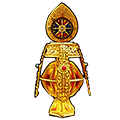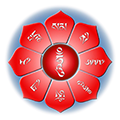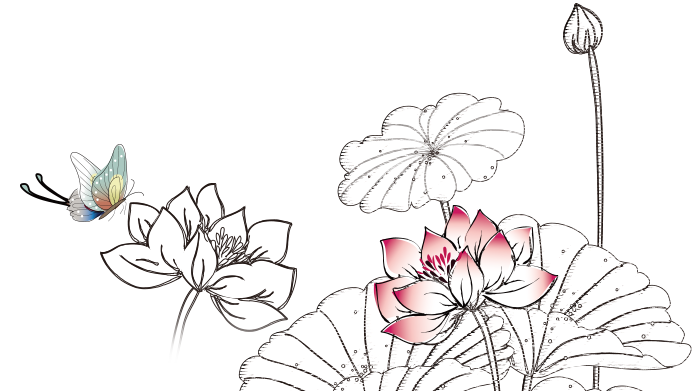Samadhi and Relinquishing
In the scriptural schools, Samadhi is concentration, one-pointedness. In the esoteric schools, Samadhi is Zen meditation. One enters Samadhi and realizes Buddhahood; that is, one uses the highest level of consciousness to realize the truth of Emptiness and then attain transcendental accomplishment. This is Samadhi.
What is Relinquishing? According to Buddha Shakyamuni in the Diamond Sutra, `My teachings may be likened to the raft. If the Buddha-teaching must be relinquished, how much more so must be the misteaching!` What this means is that, like a raft that has to be relinquished when one reaches the shore, the Buddhadharma ultimately has to be relinquished.
However, during the path of cultivation, some practices have to be relinquished while others cannot. The decision has to be made with wisdom. Thus, in order to receive the bestowal of blessing from the root guru, one should not relinquish the Guru Yoga. [audience applause] To attain the merits of one`s Personal Deity, one cannot relinquish the Personal Deity Yoga. [audience applause] To succeed in any general undertaking that needs the aid of the Dharma Protectors, Daka or Dakinis, one must not relinquish the Karma Yogas. [audience applause] How about other practices? You must employ your wisdom to make a decision. Along the graduated stages of the pathway, after achieving a yogic response on a certain stage, one will be ready to embark on the next level. Here one must decide which additional practice to take on, and which part of one`s current practice needs to be given up. This is something which requires a thoughtful decision. [audience applause] This is the awareness of relinquishing.
Involved in these decision makings is a subtle challenge, because it is sometimes difficult for one to let go of a practice in which one has been experiencing yogic response. For example, say you have become so attached to the great joy derived from your response in the Four Preliminary Practices, that you have no desire for other practices. At such times, it is important to make a wise choice. Do you want to move on to the next level? How may you adapt your current practice to the new plan: which practices to keep, which to add, and which ones to relinquish? It is a judgment based entirely on your wisdom. This is the meaning behind the Buddha`s words, `My teachings may be likened to the raft. If the Buddha-teaching must be relinquished, how much more so must be the misteaching!`
The Flexible Precepts
Here I would like to bring up the problem of precepts. When we first become Buddhists, we must abide by the precepts completely. However, precepts are alive and not rigid. A very important point is: how to employ the precepts in a flexible way. This again requires supreme wisdom. Precepts are not to be inflexibly clung to.
Some people say, `Do not kill.` That is correct, so you stick to this precept and tell yourself, `I absolutely must not kill, not even an ant.` This morning I saw a bee buzzing around in my room, I thought to myself, `Should I kill it? If I don`t, I am going to get stung in a while when I work on my writing. This side of my face will be swollen and it will show up in the videotape of the discourse to be filmed this afternoon.` [audience laughter] So, after some contemplation, I opened the window and shooed it out. I also used my supreme wisdom to make a decision. [audience laughter] To kill the bee is a very simple thing, as it will give me trouble if I don`t kill it, isn`t this true? Otherwise, I would be stung. Then, suddenly, on this sixth day of the discourse, a bump will show up on my lip. People will say, `Is there something wrong with the Grand Master? Why is his lip swollen? Did someone bite him?` [audience laughter] Unjust accusations would surface. Because of these considerations, I decided to open the window and shoo the bee out. In any undertaking, we have to think through the ramifications and make our decisions accordingly.
Buddha Shakyamuni has also faced the problem of `to kill or not to kill.` A robber was going to kill five hundred merchants in a ship. In order to save the five hundred people, the Buddha killed the robber. This is a story from the Jitavaka. Has the Buddha broken the precept of `non-killing`? He has. He did this so that five hundred lives could be spared. It was a wise decision. If the robber started killing, and you told yourself, `I can`t kill, just let him kill everyone else,` [audience laughter] this would be wrong. If you had the ability to stop the robber from killing, then you must immediately decide whether or not you should kill the robber. In order to save those five hundred people, the Buddha also has killed. Therefore precepts such as `refraining from killing` are absolutely not inflexible. You might think that they are rigid, but they are actually flexible.
Take the precept of `refraining from alcohol or intoxicants` as another example. During dinner, a dish of sesame chicken is served. Since wine is used in preparing the dish, you decide not to eat any of it. Everybody else is eating the sesame chicken except you. That kind of behavior is eccentric. [audience laughter] One of the four methods taught by the Buddha as a means of drawing other people to the Buddhadharma is `participate in the same activity as other people.` When everyone is enjoying this chicken, even if you don`t want any of it, you should not show that you are repulsed by the sight of others eating it. It would be worse if you start crying! [audience laughter] You should not act that way even if you are abiding by the precept of `non-drinking.` Actually, if you want to share the Buddhadharma with other people, why not share it while sharing the sesame chicken? Or you can tell the others jovially, `Go ahead and have my share of the chicken since I am not having it.` If it were me, I would have gone ahead and eaten the chicken. [audience laughter] It would not have bothered me. [audience applause] Among the four methods of drawing others to the Buddhadharma is to join in the same activity with other people.
That is why, when you ask me to sing for you, I comply even though I am not very good at it. We had some dancing girls come to take refuge in the True Buddha School. This has happened because I have gone dancing and drawn them to the Buddhadharma. [audience applause] If you want me to go up to heaven, I will go up to heaven. If you want me to go into the ocean, I will go into the ocean and swim for you. Actually it is not easy to be the Grand Master. Yesterday, some students were trying out the parallel bars, so I also demonstrated a few movements on them. People were wondering if I was a capable chi practitioner. Seeing what I was able to do on the parallel bars at the age of fifty, they were impressed. [applause] Among our students, Sifu Wong from England and another student from Alaska are both kung-fu masters, so I joined them and showed a few hands. [applause] Sifu Wong demonstrated his Mantis Fist while I showed my Crab-style Fist. [audience laughter and applause] This is known as `joining in the same activity as others.`
So, precepts are flexible. One of the stanzas in the Fifty Stanzas of Guru-devotion states that stepping on the shadow of one`s guru is a transgression as grave as destroying a pagoda. However, yesterday, while several hundred of us were climbing up the hill at the Rainbow Villa compound, how could one avoid stepping onto my shadow? According to the precepts, one is finished when one treads on my shadow. [audience laughter] That was why I told everyone to disregard the precept under such circumstances. The trail was so overcrowded with people going up and down, if you did not step on my shadow, you were alienating yourself from me and not joining in the same activity. It is true that the root guru is venerable, and one should be attentive and courteous to him but, under the crowded conditions yesterday, even if you had not deliberately wanted to tread on my shadow, you would have no choice when others pushed you. [laughter, audience laughter and applause] This is why precepts are flexible, and this flexibility has to do with knowing when and what to `relinquish`!
Everything is fundamentally empty, devoid of a separate existence. This is what Emptiness means in the Buddhadharma. When one reaches Perfect Enlightenment, whatever one does is in accordance with the Universal laws. In this state, one is free and abides completely in a blissful and tranquil condition. It is a perfect and transcendental state that flows naturally and spontaneously.
People have accused the True Buddha School of advocating `shen tung` [miracles] and manufacturing a lot of hot air! Where is the hot air? If one eats a lot of beans, of course there will be a lot of hot air and noise! [audience laughter] That would be `chi tung` [passing of gas] and not `shen tung` [miracles]. Everything is spontaneous and just `as is.` To heal others, I just visualized the Life Force from the Universe flowing into their bodies to empower them, and they became cured. This was not deliberately done for the purpose of creating miracles. The outside talk which says that the True Buddha School and I like to emphasize miracles is therefore groundless! I am just living my life `as is.` Wherever I go, whatever I desire just manifests spontaneously. If people want to insist that there is some kind of `tung,` then they must go and manufacture it ?all this `shen tung` has nothing to do with me. [audience laughter and applause]
In Buddhism, Emptiness is this freedom from, and non-attachment to a self. Earlier, I asked, `Where are you from?` The answer `from the Empty Space` which someone gave was quite correct. Emptiness exists everywhere; everywhere is Emptiness. The innate Buddha Nature is fundamentally the Empty Space. Where does one live? One lives in the Empty Space. Only a realized Buddha has this kind of insight. [laughter, audience laughter and applause] The truly great accomplishment is to abide peacefully and tranquilly in this state of Emptiness. In this liberated and free condition wherein one`s mind abides in the true and universal law of Emptiness, `precepts` become unnecessary, and thus there are no `precepts` for one to break.
The Remarkable Lineage
The lineage of our school is remarkable. Yesterday, after hiking down the mountain, we saw a rainbow colored aureole around the sun. Actually, the same auspicious phenomenon of a circular rainbow also could be observed around the sun during the consecration of the Pootee Lei Tsang Temple at Vancouver. I had not told the sun, `Please do me a favor, put a wreath around yourself!` [audience laughter] I did not do that at all. It could have been a windy or rainy day, but a rainbow aureole appeared. I did not notice it until others pointed it out to me. This spontaneous phenomenon is a sign of auspiciousness, a validation of the remarkableness of the True Buddha School.
We have all originally come from the Great Sun Tathagata (Mahavairocana) who exists in the realm of Emptiness. From the Mahavairocana emerged the Buddha Eye Buddha Mother (Buddha Locana) whose two eyes are the site of Ch`ang Chi Kuang T`u (the Realm of Eternal Peace and Light). These two eyes further transformed into the Maha Twin Lotus Ponds. Inside the Twin Lotus Ponds Padmakumara manifested. When Padmakumara incarnated into the human world, he became Sheng-yen Lu. [audience applause] Actually I have not come here alone, many Padmakumaras have also come here. All of you have an affinity with Padmakumara and are all Padmakumaras. [audience applause] In the future, all of us will return to the Maha Twin Lotus Ponds ?the realm of Buddha Locana ?which is equivalent to returning to the realm of Mahavairocana. Therefore, the authentic lineage of the True Buddha School is as follows: Mahavairocana ? Buddha Locana ? Padmakumara. This lineage is one hundred percent accurate. [audience applause]




